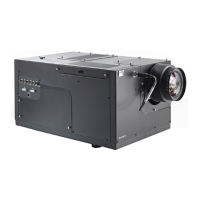A. NVG option
A. NVG OPTION
A.1 Description
NVG option modes
The NVG (Night Vision Goggles) is an option at order time, that can be implemented during production
on a SIM 7 to ensure a
realistic night vision simulation, fully compatible with night vision goggles. This technology offers improved contrast, deep black
levels and subtle gray shading.
Two different NVG options can be ordered, but they are mutually exclusive:
• IR enhanced: the image is displayed with the nature-like ratio between visual and IR light. This allows the use to see a realistic
night scenery both with and without night vision goggles, without changing any setting to the projector
• IR only: the image is displayed with IR light only. It can only be seen through night vision goggles.
Technology
This technology is based on dedicated optical filters that automatically move into the light path from a certain TOD (Time Of Day)
setting on. In practice, this optical filter comes in when TOD drops below a value of 1001. At the same time, Dynacolor (if enabled)
switches over to a NVG set (i.e. Set 3), to improve the quality level of the displayed night scenery. As soon as the TOD value raises
above 1000, the NVG filter moves out and Dynacolor switches over to set 2, being the set with advanced color tracking through CLO.
During the NVG mode of the IR only option, the input signal available on the Green channel only is processed. The input signals
for Red and Blue are omitted. The Green input signal is converted to red and processing is done by the Red channel of the projector.
During the NVG mode of IR enhanced, the full color signal (R, G and B) is processed.
The Lamp Runtime counting is doubled when the NVG filter is moved into the light path (i.e. if TOD drops
below 1000).
A.2 Description of a full dimming cycle
Introduction
The operator does not have to perform any action other than lowering the TOD value. This can be done through the projector’s OSD
or by sending commands using the API protocol (e.g. through the IG).
Dimming from full light transmission to a TOD value lower than 1000
Assume that we want to dim the light output, starting from a TOD of 10000 and end up with a TOD value of 100. The following
sequence will be followed:
1. First phase (TOD value is lowered, but has not reached 1001 yet): ECR is dimming the light output until it comes to its minimum,
being 40%
2. Second phase (TOD value is further lowered to 1001): CCD starts further dimming the light output
3. Third phase (TOD is set to 1000):
- NVG filter moves into the light path
- ECR returns to full transmission
- CCD returns to full transmission
- NVG Dynacolor set is enabled
4. Fourth phase (TOD drops further below 1000): ECR is dimming the light output until it comes to its minimum, being 40%
5. Fifth phase (TOD value is further lowered to 100): CCD starts further dimming the light output
Increasing the light transmission from a TOD value below 1000 to full transmission
Assume that we want to go back from a TOD value of 100 to full light transmission, ending up with a TOD value of 10000.The
following sequence will be followed:
R59770198 BARCO SIM 7D 13/02/2013
167

